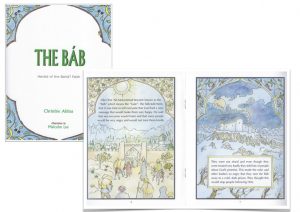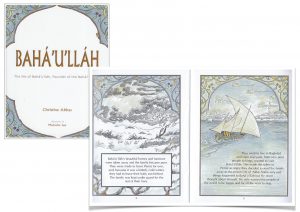
Under each topic below, you will find presentations, links to audio-visual material, classroom activities and in some cases schemes of work and lesson plans, as well as teachers’ notes.
In addition to the downloadable resources, the following items are available for purchase from the Warwick Bahá’í Bookshop:
- a range of booklets aimed at younger children, containing prayers and short quotations from Bahá’í scripture;
- a collection of eight A5-sized cards, each with a colour photograph of one of the Continental Houses of Worship (see ‘Holy Places’ below)
Other useful resources for this age group include:
- Dayspring – a Bahá’í magazine for children aged 5 to 12. It is inspired by the teaching of Bahá’u’lláh that “The earth is one country and mankind its citizens”. Published approximately three times a year, you can access PDF downloads by following this link;
- Brilliant Star magazine is a resource designed primarily for children of Bahá’í families and their parents and teachers, but many of the materials, stories and activities would be suitable for introducing Bahá’í concepts to primary-age pupils in the classroom;
- various resources on the Bahá’í Faith are available on Twinkl (you or your school will need an account to download these);
- though not specifically Bahá’í in content, the Jubilee Centre for Character and Virtues of the University of Birmingham has developed a programme of study in virtues education for primary schools.
We would love to hear about your experiences of using any of our materials, so do please let us know how you get on, using the contact form.
Bahá’í beliefs about God
- Bahá’ís believe there is one God and that all the universe and creation belong to him
- God is omnipotent, perfect and has complete knowledge of life
- Bahá’ís believe that there has only ever been one God, who is called by different names in different religions
- God is too great to be ever understood by the finite human mind
- Knowledge of God means knowledge of the attributes of God
- The only thing we can actually know about God is that God exists
Knowing about God
Since we can’t comprehend God directly, the best way to get an idea of God is by looking at the lives and teachings of his messengers, and at the world God created.
Unity
A key principle of the Bahá’í Faith is unity. There are many quotations in Bahá’í scripture on this topic, and several of them have been used as the basis for songs and activities suitable for use with young children. The following lesson plan is based on an exploration of a song.
![]() Lesson plan: We are drops of one ocean
Lesson plan: We are drops of one ocean
![]() Song: We are drops of one ocean (YouTube)
Song: We are drops of one ocean (YouTube)
The Báb was born in Iran in 1819, and in 1844 he declared that he was a Messenger of God. The title “Báb” means “Gate” and he said he was the gateway to the next religion, which would unite the world. He brought new teachings and had many followers. But the authorities did not like this and he spent several years in prison.
The Báb promised that another messenger would come after him. This was Bahá’u’lláh, who was born in Tehran on the 12th November 1817, in the country of Persia, now called Iran. His parents, who were very wealthy, gave him the name Husayn Alí. Bahá’u’lláh, which means “the Glory of God”, was a title he took later in life.
‘Abdu’l-Bahá was the son of Bahá’u’lláh. He shared his Father’s sufferings and was with him during his exiles. He always tried to help his Father and to look after the other Bahá’ís. When Bahá’u’lláh died, he appointed ‘Abdu’l-Bahá to guide the Bahá’ís. There are many stories about the life of ‘Abdu’l-Bahá, who set an example of behvaiour that all Bahá’ís try to follow.
Several Bahá’í stories can be found here, in a version designed to be read to children.
Two books, one about the Báb and one about Bahá’u’lláh (see Holy Figures, above) tell the story of the lives of these important figures in words and pictures suitable for KS1 children. They are available to order from the Warwick Bahá’í Bookshop.
Many appealing stories are told of the life and works of ‘Abdu’l-Bahá, the son of the faith’s founder, Bahá’u’lláh. Bahá’ís regard ‘Abdu’l-Bahá as an ideal example of how to live a pure and valuable life.
The following lesson plan uses a story from the life of ‘Abdu’l-Bahá to illustrate the virtue of helpfulness. It is suitable for use with children from Reception to age 8.
![]() Lesson plan : The Proud Helper (1.8 Mb – includes the storybook and separate large format pictures)
Lesson plan : The Proud Helper (1.8 Mb – includes the storybook and separate large format pictures)
Prayer
The spiritual teachings of Bahá’u’lláh, founder of the Bahá’í Faith, emphasise that God is all around us, and that an act of worship takes place everywhere that God is mentioned. A poetic and simple prayer, Blessed is the spot, demonstrates this and can be used as the basis of a lesson.
![]() Powerpoint slide : Blessed is the spot
Powerpoint slide : Blessed is the spot
![]() Lesson plan : Blessed is the spot
Lesson plan : Blessed is the spot
![]() Song : Blessed is the spot (YouTube)
Song : Blessed is the spot (YouTube)
Virtues
Examples of virtues: Courage, Courtesy, Obedience, Patience, Service, Thankfulness, Truthfulness…
The Bahá’í teachings place great emphasis on the importance of acquiring virtues as we go through life, starting in earliest childhood. There are various materials available online, focussing on particular virtues and helping children to understand what they are and why it is important to practise them. The Radiant Hearts website, with a wealth of materials, may be accessed here.
Worship can take place anywhere, but most Bahá’í devotional meetings take place either in a private home or in a Bahá’í Centre. In the future, each town or village will have its own Mashriqu’l-Adhkar, or House of Worship. Mashriqu’l-Adhkar literally means “Dawning Place of the Remembrance of God”. In the fulness of time, each House of Worship will also offer “institutions of social service” that relieve suffering, sustain the poor, and provide shelter, solace and education – such as a care home, a clinic, a library or a hostel.
Each House of Worship is circular in shape, has nine sides, and is surrounded by nine gardens. All the world’s Scriptures are read there, and the building is open to people of all races and of all religions or none. The first to be built was at Ishqabad (Ashkabad) in what is now Turkmenistan. It was confiscated by the Soviet authorities, and later suffered earthquake damage. There is one Mashriqu’l-Adhkar in each continent at present. The latest one was opened in Santiago, Chile, in October 2016. The architecture of some of these buildings is very striking, particularly that of the Chile temple and the one in India. Known as the “lotus temple”, the House of Worship in New Delhi is built on the design of a giant lotus flower.
Photos of each of the eight Houses of Worship can be downloaded from the Other Resources page.
Activities
Children can be asked to describe or draw a place that is special to them. This can be followed by showing this web-based presentation on Bahá’í Houses of Worship.
After watching the presentation, children can find where each Bahá’í House of Worship is on a map of the world. They can then create a special place in the classroom. They can make a list of the things they might put in it, and bring something special from home to share.
A pack of A5-sized cards showing each of the eight Bahá’í Houses of Worship is available for purchase from the Warwick Bahá’í Bookshop.


